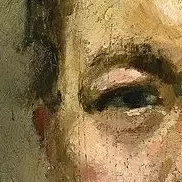At the 1905 Salon d’automne, Derain shared the same gallery as Matisse, Vlaminck and Van Dongen. A critic, noticing a sculpture by Albert Marque in the middle of these vividly coloured paintings, remarked : “Mais c’est Donatello parmi les fauves!” (“Look, it’s Donatello among wild beasts!”). The phrase caught on and gave origin to the word “Fauvism”.
Rather than being a structured movement, Fauvism was a point of agreement between young painters for whom pure colour was to serve as the expressive and emotional transcription of the world rather than a means to create the illusion of reality.
A few months later, encouraged by the art dealer Ambroise Vollard, Derain went twice to London where he produced some thirty paintings. Charing
Cross Bridge is recognised as one of the finest Fauvist compositions. The street and buildings are painted in large flat tones while the changing sky and water are treated in small, fragmented touches reminiscent of the Neo-impressionist style.
The forms of the vehicles are distorted, their silhouettes echoing the curb of the Victoria embankment to give a sensation of speed.
Fauvism was short-lived but provided the transition between figurative painting and the main movements in 20th-century painting which were to move further and further into abstraction. Derain thus declared: “Painting is too beautiful to be reduced to images which may be compared with those of a dog or horse. It is imperative that we escape the circle in which the realists have trapped us.”
https://www.musee-orsay.fr/en/artworks/pont-de-charing-cross-10872

